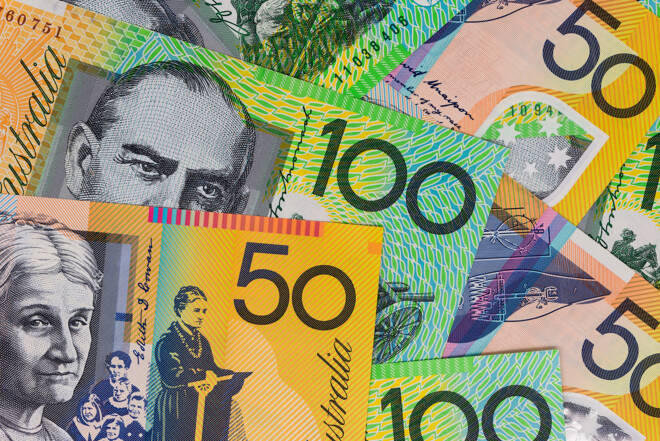Advertisement
Advertisement
AUD to USD Forecast: Aussie’s Turbulence Amid Central Bank Decisions
By:
Aussie dollar's fate hangs between RBA's minutes and Fed's interest rate deliberations.
Highlights
- The AUD/USD witnessed a slight drop of 0.18% on Friday, concluding the week up by 0.84%.
- Central banks, particularly the PBoC and the Fed, influence the global currency landscape.
- Improving views on China’s economy might bolster the AUD/USD, challenging the US dollar’s ascendancy.
Friday Overview
On Friday, the AUD/USD declined by 0.18%. Following a 0.28% gain on Thursday, the Aussie dollar ended the week up 0.84% to $0.64278. The Aussie dollar rose to a Monday high of $0.64735 before falling to a low of $0.64246.
Central Banks Take Center Stage
Economic indicators from China and the US eased fears of a US hard landing and slower growth in China. While the People’s Bank of China (PBoC) takes steps to support the Chinese economy, one final rate hike remains on the table for the Fed.
In contrast, the markets have closed the door on further RBA interest rate hikes. There is also uncertainty about whether the RBA was able to navigate the Australian economy across a narrow path to avoid a recession.
This week, the RBA meeting minutes will give investors a better sense of the thought process among board members. After the market reaction to the RBA interest rate decision, investors will likely stay cautious ahead of the Tuesday minutes.
Beyond monetary policy expectations, market risk sentiment could test the buyer appetite for the Aussie dollar.
All Eyes on the Federal Reserve and the Economic Projections
Recent economic indicators support market bets on the Fed leaving interest rates unchanged in September. However, uncertainty lingers over the November interest rate decision.
On Wednesday, the Fed interest rate decision is unlikely to deliver a surprise. However, the FOMC economic projections could spook the markets. Considering the latest US economic indicators, the Fed could have one interest rate hike left in the bag. With the US economy performing better than anticipated, the next set of economic indicators needs consideration.
The FOMC economic projections will show which way the Fed is leaning regarding inflation, the economy, unemployment, and most importantly, interest rates. While the immediate focus will be on rate hikes, investors should also factor in the projected timing of a first Fed rate cut.
Short-Term Forecast
Economic projections and central bank rhetoric will likely favor the US dollar. However, improving sentiment toward the Chinese economy could offer the AUD/USD further support over the near term. However unlikely, the Fed could throw a curveball on Wednesday and raise rates one final time.
AUD/USD Price Action
Daily Chart
The AUD/USD remained below the $0.64900 resistance level as well as the 50-day and 200-day EMAs, reaffirming bearish price signals. A break above the $0.64900 resistance level would support an AUD/USD move toward the 50-day EMA.
However, risk-off sentiment would give the bears a run at the $0.63854 support level. A break below the $0.63854 support level would bring the trend line into view.
The RSI reading of 44.97 shows the AUD/USD can return to sub-$0.64 before entering oversold territory.
4-Hourly Chart
The AUD/USD sits at the 50-day EMA, signaling short-term bullishness, but remains below the 200-day EMA, indicating long-term bearishness.
An AUD/USD breakout from the 50-day EMA would support a move toward the 200-day EMA and the $0.64900 resistance level into play.
However, a break below the 50-day EMA would signal an AUD/USD move toward the $0.63854 support level. Risk-off sentiment ahead of the Fed interest rate decision could drive selling pressure.
Considering the RSI at 48.63, the Aussie dollar has room to return to $0.64 before entering oversold territory.
About the Author
Bob Masonauthor
With over 28 years of experience in the financial industry, Bob has worked with various global rating agencies and multinational banks. Currently he is covering currencies, commodities, alternative asset classes and global equities, focusing mostly on European and Asian markets.
Advertisement
